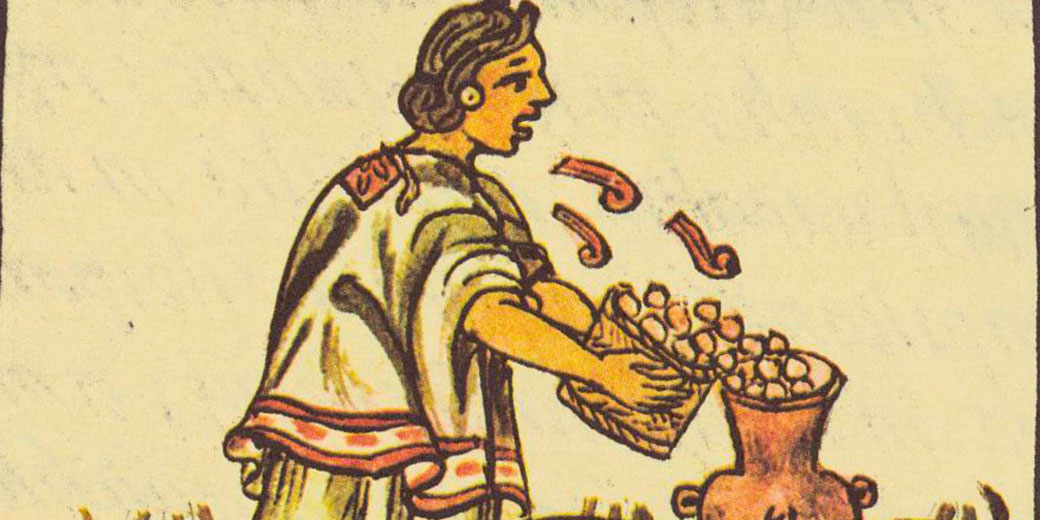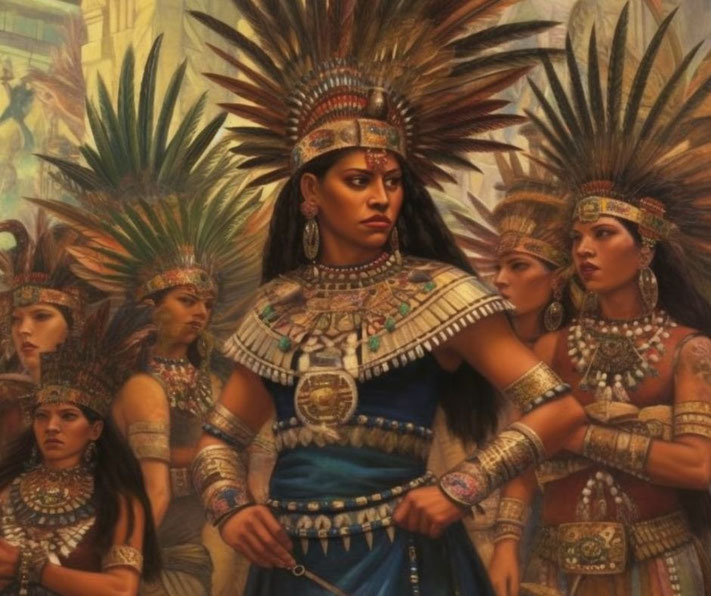What was life like for women and girls in the Aztec Empire?

Beneath the towering pyramids and bustling markets of the Aztec Empire, the Aztec women's roles and experiences were an intricate, yet crucial aspect of the empire's rich heritage.
Far from being passive bystanders, these women were the beating heart of their communities - educators, traders, artists, mothers, and sometimes warriors, weaving together the social, economic, and religious threads of their society.
Yet, how did Aztec women navigate their society's expectations and hierarchies?
What roles did they play in family life and religious practices?
How did they contribute to, and cope with, the turmoil of warfare and the cataclysmic impact of the Spanish Conquest?
The patriarchal world of the Aztec Empire
The Aztec civilization, like many pre-Columbian societies, was hierarchical, with nobles (pipiltin) and commoners (macehualtin) forming the major social strata.
However, in both of these social groups, Aztec women wielded a certain degree of power and influence, playing defined roles that contributed to the functioning and well-being of their communities.
Gender roles in Aztec society were well-defined, with clear expectations for both men and women.
While men were often warriors, political leaders, and high priests, women were entrusted with the crucial tasks of managing the household and participating in economic activities, thus playing an essential role in the survival and stability of the empire.
However, this should not be perceived as Aztec society wholly confining women to domestic roles.
Women could own and inherit property, engage in trade, and were often active participants in religious ceremonies.
In fact, there are records of women becoming well-respected painters, public speakers, performers, and singers.
Early childhood and education of girls
The birth of a child in the Aztec society was marked by rituals and celebrations, which not only reflected the cultural richness of the Aztec civilization but also underscored the expectations placed on the child from a young age.
The birth of a daughter was greeted with joy and anticipation. Mothers and midwives would conduct a series of rituals and prayers to the goddess of childbirth, Tlazolteotl, as well as other deities, signifying the spiritual significance of bringing a new life into the world.
The naming of girls in Meso-America was very different from the modern world. Most were simply named 'the oldest', the 'middle child', or the 'youngest', rather than being given a real, personal name.
This may be due to the fact that the parents wanted to wait until they had a sense of their personality before choosing a name that would suit them.
During infancy, young Aztec girls were mostly cared for by their mothers, their first and most important role models.
In these early years, mothers would pass on fundamental life skills and knowledge to their daughters.
The home served as the primary site of learning, where girls were initiated into the roles and responsibilities they were expected to fulfill in adulthood.
By the age of five, girls would have begun to learn how to make yarn, as well as how to cook and clean.
It is said that all little girls were taught the prayers she would say in her future wedding ceremony, along with the regular ones which were used on a daily basis.
They would also be taught how to spin yard, weave cloth, and master the art of embroidery.

As they grew older, the education of Aztec girls was structured around their expected roles as adults.
At around 12 years of age, girls would usually attend a local school called cuicacalli ("house of song") where they were further trained in domestic tasks and also learned about religion, ethics, and societal values.
The cuicacalli was part of the larger institution known as the telpochcalli ("youth house"), which educated the majority of Aztec children and also provided military training for boys.
However, girls from noble families sometimes attended the calmecac, a higher institution of learning typically reserved for nobles and those chosen for religious service.
The calmecac provided a more comprehensive education, including lessons in history, mythology, astronomy, ethics, art, and music.
This divergence in education reveals the nuanced stratification of Aztec society and reflects the varying expectations for girls of different social statuses.
Marriage and family life
Marriage in Aztec society was an important institution, not merely symbolizing the union of two individuals, but also serving as an alliance between families and, in some cases, a way to establish political ties between different factions within the empire.
For women, marriage was a significant event that would shape their status, responsibilities, and lifestyle.
While most marriages were arranged by the parents, it wasn't uncommon for the prospective bride and groom to have some say in the matter.
A series of rituals, involving both families, would precede the wedding. This often included a feast, the exchange of gifts, and the invocation of blessings from various deities.
Upon marriage, an Aztec woman typically moved into her husband's home, marking the beginning of her role as a wife and eventually a mother.
Within the household, Aztec women assumed the role of primary caretakers and household managers. They were responsible for tasks such as cooking, cleaning, and managing domestic resources.
Aztec women held considerable influence within their households. Childbearing and child-rearing were considered sacred duties for Aztec women.
As wives, they could elevate their family's status; as mothers, they shaped future generations of workers, warriors, and leaders.
The intimate space of the home was not just a site of domestic work, but also a stage where power was negotiated, traditions were upheld, and societal values were both challenged and reinforced.
Women's roles in the economy
The economic contributions of women in the Aztec Empire were significant, and their influence extended beyond the domestic sphere.
Aztec women were involved in a variety of occupations, contributing to the economy through activities such as farming, trading, and craft production.
Agriculture was the backbone of the Aztec economy, and while men primarily tended to the fields, women also played a crucial role.
They were responsible for processing agricultural products, like grinding maize into dough for tortillas, preparing other foodstuffs, and spinning and weaving cotton for textiles.
The production of these goods not only sustained the family but often served as commodities for trade in local markets.
Markets were the economic centers of the Aztec Empire, bustling hubs of trade where goods from all corners of the empire were exchanged. Here, women were actively involved as traders or merchants.
Some women were part of the pochteca, the professional merchant class, who often undertook long trade expeditions and amassed considerable wealth.
Craft production was another area where women contributed to the economy. They were skilled potters, weavers, and jewelers, creating goods for both domestic use and trade.
The finely woven textiles produced by Aztec women were particularly prized and served as a form of currency in the Aztec economy.
One notable aspect of the Aztec society was that women had the right to own property.
They could inherit land and pass it onto their children, which indicates a level of economic autonomy and influence not commonly associated with pre-Columbian societies.

Did women have a role in Aztec religion?
Religion was a central component of Aztec life, permeating every aspect of their society, and women were active participants in these spiritual realms.
In private religious practices, Aztec women would offer prayers and sacrifices to the household gods, perform rituals related to birth, marriage, and death, and teach their children about the pantheon of Aztec deities and the religious customs of their society.
One of their favorite goddesses was Cihuacoatl, the Woman-Snake, who was represented with a spear and shield.
This deity was particularly worshipped by midwives, when it was believed that she helped birthing mothers seize a new spirit from the cosmos and help it to enter their into their child.
At the communal level, women participated in a variety of religious festivals and ceremonies.
They played roles in agricultural rites, fertility rituals, and offerings to various deities.
In these public rites, women's contributions were essential for the successful communication with the divine, a testament to their religious significance in the Aztec society.
The Aztec pantheon included several powerful female deities, such as Coatlicue, the earth goddess, Tlazolteotl, the goddess of childbirth and fertility, and Xochiquetzal, the goddess of beauty, love, and female sexual power.
The existence of these goddesses speaks volumes about the spiritual agency of women and the reverence given to feminine powers in Aztec religion.
Beyond their roles as worshippers, some women held formal religious roles as priestesses, serving specific deities, maintaining temples, and even leading certain ceremonies.
In the most sacred religious institution, the calmecac, there were women known as cihuapipiltin ("honored women"), who devoted their lives to the service of the gods.
The role of Aztec women in warfare
While it was predominantly a male domain, the influence of women in Aztec warfare should not be overlooked.
The primary contribution of Aztec women to warfare was through support roles. Women were responsible for providing food, clothing, and other supplies to their warrior kin.
They prepared meals for the soldiers, wove clothing and uniforms, and crafted items like the ichcahuipilli, a type of padded cotton armor worn by Aztec warriors.
These efforts, while not often highlighted, were crucial to sustaining the military efforts of the Aztec Empire.
Beyond these supportive roles, Aztec women also held symbolic importance in the context of warfare.
The mother of a warrior held a high status and was expected to encourage her son's bravery and martial prowess.
When a warrior fell in battle, his mother was honored with his weapons and shield, recognizing her role in raising a brave soldier.
Interestingly, there are historical accounts of women participating directly in battles.
In exceptional cases, women were known to have fought alongside men, defending their cities during sieges.
Such instances of women in combat, while not the norm, demonstrate the fluidity of gender roles during times of crisis.
Lastly, women also influenced Aztec warfare through their roles in religion.
Goddesses like Coyolxauhqui, the celestial warrior goddess, and Itzpapalotl, the obsidian butterfly often associated with warrior souls, underscored the spiritual aspects of warfare and served as divine patrons for Aztec warriors.

The impact of the Spanish conquest on Aztec women
The Spanish Conquest, led by Hernán Cortés in the early 16th century, had profound and devastating impacts on the Aztec Empire, leading to its eventual collapse.
Aztec women experienced these impacts in specific and often devastating ways, their lives irrevocably changed by the violence, disease, and cultural upheaval brought about by the conquest.
With the arrival of the Spanish and their indigenous allies, the Aztec society was exposed to diseases such as smallpox, measles, and influenza, against which they had no natural immunity.
These epidemics decimated the indigenous population, including a significant number of women.
This not only resulted in the loss of many lives but also disrupted family structures and societal roles that Aztec women had upheld.
During the violent conflicts and in their aftermath, many Aztec women were subjected to physical abuse, exploitation, and slavery by the Spanish.
Women, as bearers of culture and the primary caregivers, suffered enormously during these upheavals.
In terms of societal structure and roles, the Spanish Conquest and subsequent colonial period led to a marginalization of women's roles.
The Spaniards imposed their own social norms, which included stricter gender roles based on their patriarchal society.
The economic, religious, and social agency Aztec women once enjoyed was significantly reduced, as they were often confined to domestic spaces and largely excluded from public and political life.
However, despite these adverse conditions, Aztec women also played crucial roles in the survival and resilience of their culture.
Malinche, also known as Doña Marina, is one of the most famous Aztec women from this period.
She served as an interpreter and advisor to Hernán Cortés and played a significant role in his interactions with the Aztec emperor Moctezuma II.
Though often viewed controversially, Malinche's story underscores the complex realities of women's experiences during the conquest.
Furthermore, Aztec women, through their roles as mothers and caregivers, were instrumental in preserving and transmitting cultural knowledge and traditions in the face of Spanish attempts at cultural assimilation.
They ensured the survival of indigenous languages, stories, and customs, laying the foundation for the enduring influence of Aztec culture in Mexico today.
Further reading
What do you need help with?
Download ready-to-use digital learning resources
Copyright © History Skills 2014-2025.
Contact via email
With the exception of links to external sites, some historical sources and extracts from specific publications, all content on this website is copyrighted by History Skills. This content may not be copied, republished or redistributed without written permission from the website creator. Please use the Contact page to obtain relevant permission.





